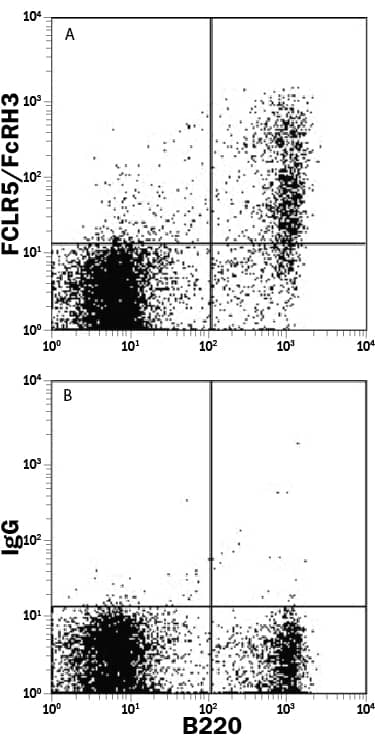Mouse FCRL5 APC-conjugated Antibody
R&D Systems, part of Bio-Techne | Catalog # FAB6757A


Key Product Details
Species Reactivity
Mouse
Applications
Flow Cytometry
Label
Allophycocyanin (Excitation = 620-650 nm, Emission = 660-670 nm)
Antibody Source
Polyclonal Sheep IgG
Product Specifications
Immunogen
Mouse myeloma cell line NS0-derived recombinant mouse FCRL5/FcRH3
Gln27-Ala496 (predicted)
Accession # NP_899045
Gln27-Ala496 (predicted)
Accession # NP_899045
Specificity
Detects mouse FCRL5/FcRH3 in direct ELISAs. In direct ELISAs, less than 1% cross-reactivity with recombinant human FCRL5 is observed.
Clonality
Polyclonal
Host
Sheep
Isotype
IgG
Scientific Data Images for Mouse FCRL5 APC-conjugated Antibody
Detection of FCRL5 in Mouse Splenocytes by Flow Cytometry.
Mouse splenocytes were stained with Rat Anti-Mouse B220/CD45R Fluorescein-conjugated Monoclonal Antibody (Catalog # FAB1217F) and either (A) Sheep Anti-Mouse FCRL5 APC-conjugated Antigen Affinity-purified Polyclonal Antibody (Catalog # FAB6757A) or (B) Normal Sheep IgG Allophycocyanin Control (Catalog # IC016A). View our protocol for Staining Membrane-associated Proteins.Applications for Mouse FCRL5 APC-conjugated Antibody
Application
Recommended Usage
Flow Cytometry
10 µL/106 cells
Sample: Mouse splenocytes
Sample: Mouse splenocytes
Formulation, Preparation, and Storage
Purification
Antigen Affinity-purified
Formulation
Supplied in a saline solution containing BSA and Sodium Azide.
Shipping
The product is shipped with polar packs. Upon receipt, store it immediately at the temperature recommended below.
Stability & Storage
Store the unopened product at 2 - 8° C. Do not use past expiration date. Protect from light.
Background: FCRL5
References
- Davis, R.S. (2007) Annu. Rev. Immunol. 25:525.
- Maltais, L.J. et al. (2006) Nat. Immunol. 7:431.
- Won, W-J. et al. (2006) J. Immunol. 177:6815.
- Davis, R.S. et al. (2004) Int. Immunol. 16:1343.
- Hatzivassiliou, G. et al. (2001) Immunity 14:277.
- Miller, I. et al. (2002) Blood 99:2662.
- Polson, A.G. et al. (2006) Int. Immunol. 18:1363.
- Vidal-Laliena, M. et al. (2005) Cell. Immunol. 236:6.
- Haga, C.L. et al. (2007) Proc. Natl. Acad. Sci. 104:9770.
- Mohan, J. et al. (2006) Blood 107:4433.
- Campbell, J.A. et al. (2010) J. Immunol. 185:28.
- Ise, T. et al. (2005) Clin. Cancer Res. 11:87.
- Ise, T. et al. (2007) Leukemia 21:169.
- Kazemi, T. et al. (2009) Cancer Immunol. Immunother. 58:989.
- Ise, T. et al. (2006) Clin. Chem. Lab. Med. 44:594.
Long Name
Fc Receptor-like 5
Alternate Names
BXMAS1, CD307e, FcRH5, IFGP5, IRTA2, PRO820
Gene Symbol
FCRL5
UniProt
Additional FCRL5 Products
Product Documents for Mouse FCRL5 APC-conjugated Antibody
Product Specific Notices for Mouse FCRL5 APC-conjugated Antibody
For research use only
